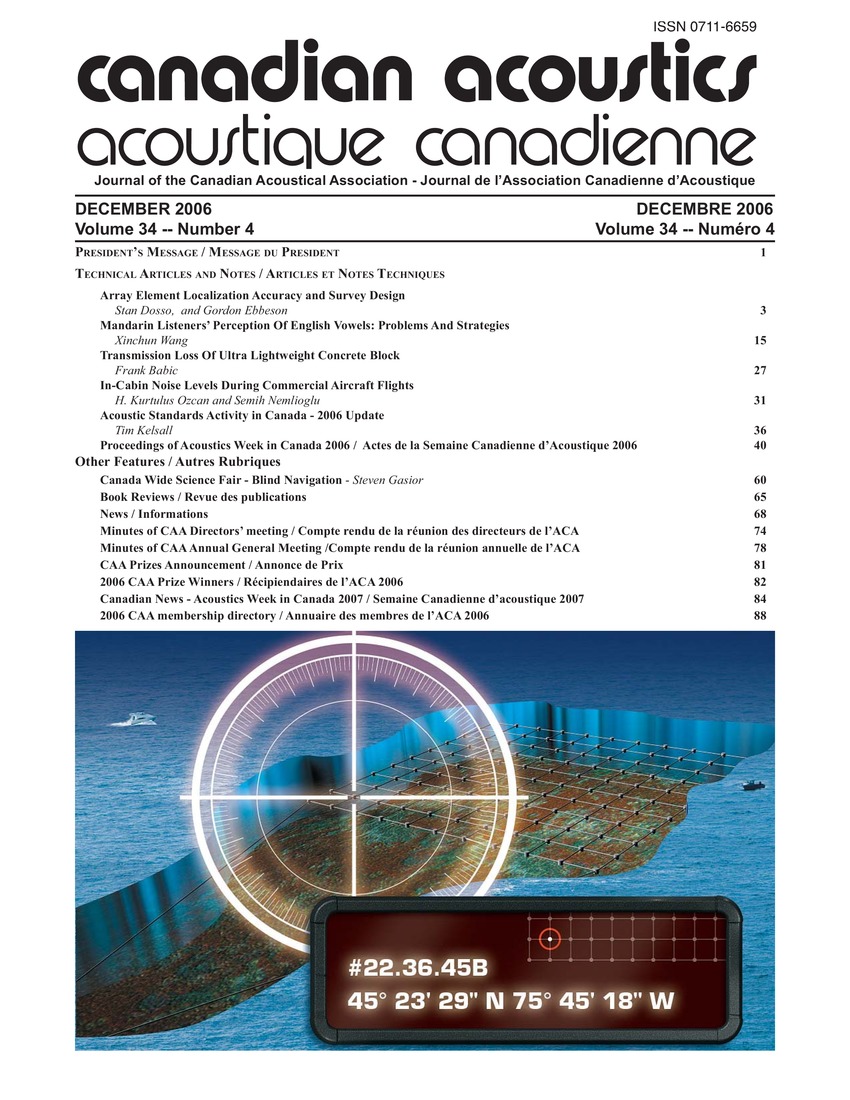Array element localization accuracy and survey design
Mots-clés :
Arrays, Optimal control systems, Signal receivers, Synchronization, Time measurement, Array element localization (AEL) methods, Optimal configurations, Survey designRésumé
La localisation precise d’elements individuels d’un etalage de récepteurs acoustiques sous-marin est un facteur important qui peut fortement influencer la validité de la manipulation de donnees. Les methodes de Localisation des Elements d’Etalage (AEL) sont typiquement basees sur l’inversion de temps d’arivee acoustiques mesures, parvenant de sources contr olees à des positions connues (approximativement), relatives aux positions des récepteurs localiser. Cet article présente et illustre une approche gnerale à l’inversion de AEL et à la planifications d’etudes de AEL, basee sur la quantification de l’incertitude postérieure de la position des récepteurs, compte-tenue de l’incertitude des donnees, de la position des sources, de la vitesse sonore, et de la profondeur d’eau. L’inversion est basee sur un algorithme rapide de traage de rayon qui utilise la methode Newton et la methode d’images pour determiner les rayons-eigen pour les arives directes et reflerées. L’efficacite de cette approche permet l’utilisation de methodes calcul informatique intense, comme évaluation Monte-Carlo et l’optimisation non-lineaire, pour la planification de configuration de sources optimale. Ces algorithmes fournissent une approche qui peut etre applique pour examiner tout les aspects de la precision et de la planification d’etudes de AEL, illustre ici par plusieurs exemples. Il est demontr ici que les etudes de AEL harmonises (pour qui les temps de transmission de source sont connues) fournissent seulement une amelioration mineure comparativement aux etudes non-harmonizes (qui ont souvent une logistique plus simple), et que la difference peut etre rcupre en utilisant plus de sources dans une configuration optimale ou en incluant des arivees additionnelles. En incluant les arivees a réflextion multiple, l’estimation de profondeur des récepteurs est ameliore (a condition que la profondeur d’eau est bien connue), mais n’ameliore que peu la localisation horizontale.Fichiers supplémentaires
Publié-e
Comment citer
Numéro
Rubrique
Licence
Author Licensing Addendum
This Licensing Addendum ("Addendum") is entered into between the undersigned Author(s) and Canadian Acoustics journal published by the Canadian Acoustical Association (hereinafter referred to as the "Publisher"). The Author(s) and the Publisher agree as follows:
-
Retained Rights: The Author(s) retain(s) the following rights:
- The right to reproduce, distribute, and publicly display the Work on the Author's personal website or the website of the Author's institution.
- The right to use the Work in the Author's teaching activities and presentations.
- The right to include the Work in a compilation for the Author's personal use, not for sale.
-
Grant of License: The Author(s) grant(s) to the Publisher a worldwide exclusive license to publish, reproduce, distribute, and display the Work in Canadian Acoustics and any other formats and media deemed appropriate by the Publisher.
-
Attribution: The Publisher agrees to include proper attribution to the Author(s) in all publications and reproductions of the Work.
-
No Conflict: This Addendum is intended to be in harmony with, and not in conflict with, the terms and conditions of the original agreement entered into between the Author(s) and the Publisher.
-
Copyright Clause: Copyright on articles is held by the Author(s). The corresponding Author has the right to grant on behalf of all Authors and does grant on behalf of all Authors, a worldwide exclusive license to the Publisher and its licensees in perpetuity, in all forms, formats, and media (whether known now or created in the future), including but not limited to the rights to publish, reproduce, distribute, display, store, translate, create adaptations, reprints, include within collections, and create summaries, extracts, and/or abstracts of the Contribution.


